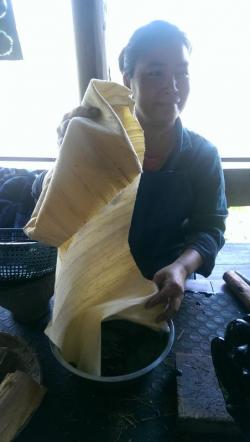Precious Lessons From World Heritage Town Of Luang Prabang
Source: Bangkok Post
Almost 40 Thai villagers and “creative tourism” advocates recently participated in several community tourism activities in Luang Prabang, Laos, looking to apply good ideas to their villages in six designated special zones.
They have learned precious lessons from these destinations — Whisky Village, Sa Paper Village, Living Land Community Farm, Ock Pop Tok Living Crafts Centre, two museums, two mountains, a temple and a walking street.
“Creative Tourism focuses on the identity or authenticity of communities. We want the villagers to see how Luang Prabang is able to develop while conserving its identity. The town is as small as 5km², but it is heritage for people worldwide. For example, activities reflect characteristics of the area as well as occupations. The heart of creative tourism is to allow tourists to learn, do things and understand,” Asst Prof Suddan Wisudthiluck, lecturer of Thammasat University’s Faculty of Sociology and Anthropology and head of the Working Party on Model Project on Creative Tourism, told Life.
 Learning to dye silk at Ock Pop Tok Living Crafts Centre. Pichaya Svasti
Learning to dye silk at Ock Pop Tok Living Crafts Centre. Pichaya Svasti
In 2013, the Designated Areas for Sustainable Tourism Administration (Public Organisation), or Dasta, and Thammasat University launched the “Model Creative Tourism Project” to enable local communities to achieve economic, social and environmental balance through creative tourism. The concept emphasises the conservation of identity. The six special zones under the project are certain areas of Sukhothai, Kamphaeng Phet and Si Satchanalai historical parks, Loei, Trat, Nan, Suphan Buri and Chon Buri.
Dasta defines Creative Tourism as “tourism that is linked to history, art, culture, community lifestyle and identities of localities, which tourists learn to gain direct experiences from owners of the culture, with opportunities to spend time with them and increase value and potentiality”.
The Thai villagers on this trip come from fishing villages in Trat and Chon Buri, a Muslim communtiy in Chon Buri, a kite-making village in Sukhothai, an embroidery community in Kamphaeng Phet, a rice-farming village and a weaving village in Loei, a Buddha statue-carving village, a blanket-making village, a lantern-making village and a basketry village in Nan, a khanom jeen noodle-making village, two basketry villages and a herbal balm-making village in Suphan Buri.
In Luang Prabang, participants learned how to dye silk by using raw materials at Ock Pop Tok, and observed the distilling of local whisky at Ban Xang Hai, or Whisky Village, and the making of Sa paper at Ban Xang Khong.
“Whisky Village is renowned for producing whisky jars and distilling local whisky. The government supports villagers to work by reducing the excise tax to 10% from 110%,” Asst Prof Suddan said. “At all these destinations, we would see different presentations, some of which match our approaches and some do not. But we can learn from procedures and apply to our areas.”
 Making sa paper at Ban Xang Khong. Pichaya Svasti
Making sa paper at Ban Xang Khong. Pichaya Svasti
The Thai villagers witnessed how Living Land Community Farm, a local community enterprise, could attract tourists to pay to learn rice farming with fun. They studied presentation strategies at Ock Pop Tok and at the non-profit Traditional Arts and Ethnology Centre.
They realised that consistency is important since all vendors at the Walking Street regularly show up to sell goods although a few tourists come during low seasons. They understood that sticky rice almsgiving and temple visits “are not a show or trend” but a religious culture for all to strictly follow and respect by dressing and doing things properly.
During the wrap-up workshop in Luang Prabang, Anusorn Foongroongnirattisai from an embroidery learning centre in tambon Ang Thong, Kamphaeng Phet, said: “What I have learned from Laos matches several lifestyles of my community, such as whisky distilling and silk dyeing before embroidery. This made us realise the importance of the conservation of local ways of life.”
Suree Phongsai, who represents fishing communities in tambon Mai Root in Trat, said the places in Luang Prabang showed how to make simple ways of life interesting. Many Thai communities offer the same type of experience to tourists, but lack the proper understanding in ways to tell their stories. In Laos, villagers had the ability to make visitors want to buy their products even though prices are high.
Bunma Kosem from a fishing village in tambon Na Klua in Chon Buri, learned presentations are important and should be done by villagers, not tour guides.
Yo Lampueng from Kok Sathon rice farming community in Muang Loei said: “My community has a rice farming culture that is almost identical to the Living Land Community Farm. I took 200-300 pictures and sent the information to fellow villagers who are now preparing to showcase our community’s identity and tell stories happily and naturally.”
Jarin Chuenjorakhe from Ban Khanom Jeen in Suphan Buri agreed with Yo and promised to highlight all procedures and real tools in promoting tourism through khanom jeen noodle making.
“Bringing all of you here is not encouraging you to copy what they do but wanting you to learn and apply their concepts to all the six special zones and 17 activities. We should focus on each area’s quality and, most important, procedures. We must learn and benefit from this knowledge. We aim to introduce creative tourism to 111 communities,” Suthep Keasang, Dasta deputy director-general, told the Thai villagers at the workshop.

